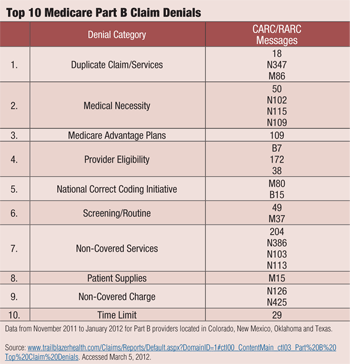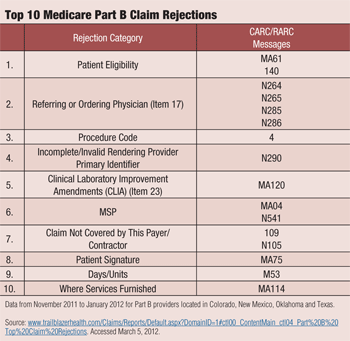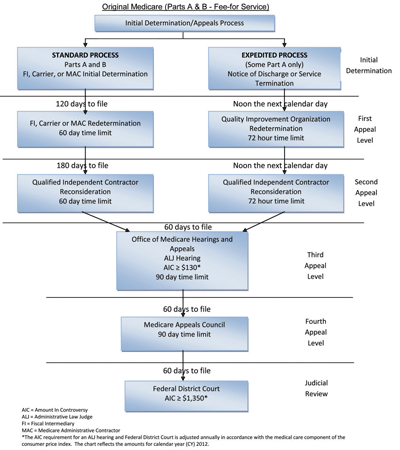It’s a very frustrating experience when you receive an Explanation of Benefits from a carrier only to find out that the claim you filed a few weeks ago has been denied or rejected for payment.
But, it’s not a matter that you have to take lying down.
Medical claim rejections and denials are a daily occurrence in most optometric practices. This article explains how to fight claim rejection and denial, using the Center of Medicare and Medicaid Services (CMS) as the prototypical carrier. CMS has a very detailed process for allowing you to fight a claim denial or rejection, with many easy-to-follow printable resources ( www.cms.gov/OrgMedFFSAppeals). Each carrier with which you have a signed provider agreement should have similar processes in place for claim adjudication. Refer to the specific carrier provider agreement or website for specifics regarding its individual processes.
Let’s take a claim through the process of submission and denial to see how to not only fight claim rejections properly, but to prevent them as well.
Submit ‘Clean’ Claims
When submitting a claim, there are very specific requirements that you must follow in order to submit a “clean” claim—that is, a claim that’s free from submitter errors and can be placed properly into the claims processing system.
Fill Out CMS-1500 Properly
There is an excellent publication
from the Medicare Learning Network that summarizes the use of the
ubiquitous CMS-1500 form—if I had to choose a single publication to read
to prevent claim submission errors, this would be it:
www.cms.gov/MLNProducts/downloads/form_cms-1500_fact_sheet.pdf
• To download a sample of the form, go to:
www.cms.gov/cmsforms/downloads/CMS1500805.pdf.
• To download the complete CMS-1500 form instructions, go to:
www.cms.gov/manuals/downloads/clm104c26.pdf.
The CMS-1500 form and its electronic equivalent are the most common claim submission forms used for professional service and durable medical equipment in the medical field. The CMS-1500 form answers the needs of many health insurers. It’s the basic form required by CMS for claims from physicians and suppliers for the Medicare and Medicaid programs. (See “Fill Out CMS-1500 Properly,” at right.) It’s been adopted by the TRICARE Program for the military, and has received the approval of the American Medical Association Council on Medical Services.
So, let’s assume that you’ve done your best to fill out the form properly, yet the claim comes back as rejected or denied.
Rejection vs. Denial
There are very important differences between “claim rejection” and “claim denial.” There are many reasons for claim rejection and denial; so let’s review the six different variations when a claim is returned to you without payment:1
 • Claim Rejection: There are one or more edits present that cause the whole claim to be rejected. A claim rejection means that the provider can correct and resubmit the claim but cannot appeal the claim rejection.
• Claim Rejection: There are one or more edits present that cause the whole claim to be rejected. A claim rejection means that the provider can correct and resubmit the claim but cannot appeal the claim rejection.
• Claim Denial: There are one or more edits present that cause the whole claim to be denied. A claim denial means that the provider cannot resubmit the claim but can appeal the claim denial.
• Claim Return to Provider (RTP): There are one or more edits present that cause the whole claim to be returned to the provider. A claim returned to the provider means that the provider can resubmit the claim once the problems are corrected.
• Claim Suspension: There are one or more edits present that cause the whole claim to be suspended. A claim suspension means that the claim is not returned to the provider, but is not processed for payment until the fiscal intermediary (FI) makes a determination or obtains further information.
• Line Item Rejection: There are one or more edits present that cause one or more individual line items to be rejected. A line item rejection means that the claim can be processed for payment with some line items rejected for payment. The line item can be corrected and resubmitted but cannot be appealed.
• Line Item Denials: There are one or more edits present that cause one or more individual line items to be denied. A line item denial means that the claim can be processed for payment with some line items denied for payment. The line item cannot be resubmitted but can be appealed.
While seemingly simple, many of us don’t understand the subtleties of these differences. Correcting an error on a claim and resubmitting it for payment is significantly easier than trying to appeal a claim to the carrier. Yet, while burdensome, it is also very important to understand the appeals process and the rights that the system affords the practitioner.
The top errors in claim submissions vary from year to year, but they are somewhat consistant. For example, the top errors for claim denials from one CMS carrier include duplicate claims/services, medical necessity, patient already enrolled in Medicare Advantage Plan, provider eligibility, non-covered services, and others. (See “Top 10 Medicare Part B Claim Denials,” above.) Some of the top errors for claim rejections include patient eligibility, missing/incomplete/invalid information for the referring or ordering provider, a procedure code that is inconsistent with the modifier, missing/incomplete/invalid information for the rendering provider, and others. (See “Top 10 Medicare Part B Claim Rejections," below.)
So, if we actually know the top reasons why claims get denied or rejected ahead of time, then we can properly review them and scrub them to ensure that we’ve addressed these problems prior to submitting to the carrier.
Correct the Causes of Rejection and Denial
Once a claim has been submitted, either it will get paid or it will get returned to the practitioner as denied or rejected without payment. In the below examples, there are many reasons listed in the right-hand column that appear on the Remittance Advice (RA) or the Explanation of Benefits (EOB) form. These Claim Adjustment Reason Codes (CARC) and/or Remittance Advice Remark Codes (RARC) can be very confusing in their meaning and definitions because they are often truncated or abbreviated on the RA or EOB.
 Fortunately, the complete lists of CARC and RARC codes are published by the Washington Publishing Company (WPC) and are listed on its website:
www.wpc-edi.com/reference.
Fortunately, the complete lists of CARC and RARC codes are published by the Washington Publishing Company (WPC) and are listed on its website:
www.wpc-edi.com/reference.
Let’s consider the top cause for claim rejection and its accompanying reason: Patient Eligibility. Two codes are listed next to that reason: MA61 and 140. If you go to the WPC website, you can look up these codes and find the definitions, so that you can correct the claim for resubmission.
• 140 (CARC): Patient/insured health identification number and name do not match.
• MA61 (RARC): Missing/incomplete/invalid social security number or health insurance claim number.
So, if I saw those codes next to a patient claim item, I would go back and review that patient’s coverage, eligibility and identification numbers. I would make the appropriate corrections and resubmit the claim to the carrier for payment.
Let’s do the same thing for the second most common cause for denial, Medical Necessity. The reason codes listed there are 50, N102, N115 and N109. Again, you can look these up and find the definitions so that you can correct the claim for resubmission.
• 50 (CARC): This is a non-covered service because the payer does not deem it a “medical necessity.”
• N102 (RARC): This claim has been denied without reviewing the medical record because the requested records were not received or were not received timely.
• N115 (RARC): This decision was based on a Local Coverage Determination (LCD). An LCD provides a guide to assist in determining whether a particular item or service is covered.
• N109 (RARC): This claim/service was chosen for complex review and was denied after reviewing the medical records.
Now you know exactly what you need to refer to when submitting the claim or responding to the carrier to get proper adjudication of the claim. No more wondering or shooting in the dark trying to figure out why the claim was not paid. Moreover, each of these issues will be preventable for your subsequent claims because you now know the specifics for claims of this nature.
I’ve Tried Everything, But Still Can’t Get Paid
Even if you are formally denied after resubmitting the claim, you are not at the end of the road. There is a formal appeals process that each carrier employs to allow the practitioner to have a voice and process to get paid. (See “Medicare Appeals Process Flowchart.")
Once an initial claim determination is made, beneficiaries, providers and suppliers have the right to appeal Medicare coverage and payment decisions. The appeals process is straightforward, but requires you to follow each step in the process to get your issues resolved. Some steps have specific monetary requirements (amount of claim) to reach, while others do not.
There are five levels in the Medicare Part A and Part B appeals process:
• First Level of Appeal—Redetermination by a Medicare carrier, fiscal intermediary (FI), or medicare administrative contractor (MAC).
• Second Level of Appeal—Reconsideration by a qualified independent contractor.
• Third Level of Appeal—Hearing by an administrative law judge in the Office of Medicare Hearings and Appeals.
• Fourth Level of Appeal—Review by the Medicare Appeals Council.
• Fifth Level of Appeal—Judicial review in federal district court.
Let’s discuss each level of appeal in order.
1. Redetermination
A redetermination is an examination of a claim by the fiscal intermediary, carrier or MAC personnel who are different from the personnel who made the initial claim determination. The appellant (the individual filing the appeal) has 120 days from the date of receipt of the initial claim determination to file an appeal. A redetermination must be requested in writing. A minimum monetary threshold is not required to request a redetermination.
A request for a redetermination must be filed either on form CMS-20027 ( www.cms.gov/OrgMedFFSAppeals/Downloads/CMS20027a.pdf) or in writing. A written request not made on form CMS-20027 must include the following information:
• Beneficiary name
• Medicare Health Insurance Claim (HIC) number
• Specific service and/or item(s) for which a redetermination is being requested
• Specific date(s) of service
• Signature of the party or the authorized or appointed representative of the party
 2. Reconsideration
2. Reconsideration
If you (or the carrier) is dissatisfied with the redetermination decision, you (or the carrier) may request a reconsideration. A qualified independent contractor (QIC) will conduct the reconsideration.
A written reconsideration request must be filed with a QIC within 180 days of receipt of the redetermination. To request a reconsideration, follow the instructions on your Medicare Redetermination Notice (MRN). A request for a reconsideration may be made on the standard form CMS-20033 ( www.cms.gov/cmsforms/downloads/cms20033.pdf). This form is mailed with the MRN. If this form is not used, the written request must contain all of the following information:
• Beneficiary’s name
• Beneficiary’s Medicare HIC number
• Specific service(s) and item(s) for which the reconsideration is requested, and the specific date(s) of service
• Name and signature of the party or representative of the party
• Name of the contractor that made the redetermination
The request should clearly explain why you disagree with the redetermination. A copy of the MRN and any other useful documentation should be sent with the reconsideration request to the appropriate QIC. Evidence not submitted at the reconsideration level may be excluded from consideration at subsequent levels of appeal unless you show good cause for not submitting the evidence.
Generally, the QIC will send its decision to all parties within 60 days of receipt of the request for reconsideration. The decision will contain detailed information on further appeals rights if the decision is not fully favorable. If the QIC cannot complete its decision in the applicable timeframe, it will inform the appellant of their right to escalate the case to an administrative law judge.
3. Hearing by Administrative Law Judge
In 2012, if at least $130 remains in controversy following the QIC’s decision, a party to the reconsideration may request an administrative law judge (ALJ) hearing within 60 days of receipt of the reconsideration decision. Appellants must send notice of the ALJ hearing request to all parties to the QIC for reconsideration.
Refer to your reconsideration decision letter from the QIC for details regarding the procedures for requesting an ALJ hearing. The standard form CMS-20034 A/B may be used to file a request for an ALJ hearing (
www.cms.gov/cmsforms/downloads/cms20034ab.pdf). ALJ hearings are generally held by video-teleconference (VTC) or by telephone. If you do not want a VTC or telephone hearing, you may ask for an in-person hearing. Appellants may also ask the ALJ to make a decision without a hearing (on-the-record).
The ALJ will generally issue a decision within 90 days of receipt of the hearing request. If the ALJ cannot issue a decision in the applicable timeframe, the ALJ will notify the appellant of their right to escalate the case to the Medicare Appeals Council.
4. Review by the Medicare Appeals Council
At this stage, if a party to the ALJ hearing is dissatisfied with the ALJ’s decision, the party may request a review by the Medicare Appeals Council. There is no minimum requirement regarding the amount of money in controversy.
The request for Medicare Appeals Council review must be submitted in writing within 60 days of receipt of the ALJ’s decision, and must specify the issues and findings that are being contested (
www.cms.gov/OrgMedFFSAppeals/Downloads/DABform.pdf). Refer to the ALJ decision for details regarding the procedures to follow when filing a request for Medicare Appeals Council review.
Generally, the Medicare Appeals Council will issue a decision within 90 days of receipt of a request for review. That timeframe may be extended for various reasons, including but not limited to the case being escalated from the ALJ level.
5. Last Chance…Judicial Review
If $1,350 or more is still in controversy following the Medicare Appeals Council’s decision, you can request judicial review before a federal district court judge. As the appellant, you must request a federal district court hearing within 60 days of receipt of the Medicare Appeals Council’s decision. The Medicare Appeals Council’s decision will contain information about the procedures for requesting judicial review.
If you have reached this stage, things are serious and you have incurred significant costs in both time and money. Fortunately, it’s rare that an optometrist ever gets to this stage of the appeals process.
Finding Balance
Navigating the maze of claim rejections and denials may be nerve-racking and frustrating; however, there are significant resources available to not only get your claim properly adjudicated, but also build a culture of prevention.
Although prevention is time consuming and frustrating in its own right, the long term savings and financial reward to your practice is certainly worth it.
Dr. Rumpakis is the founder of Practice Resource Management, a management and consulting firm. He lectures nationally and internationally on medical coding and compliance, the economics of clinical standards of care, managed care, practice appraisal and other practice management topics. He is Clinical Coding Editor for Review’s “Coding Abstract” column.
1. Centers for Medicare & Medicaid Services website. January 2007 Outpatient Prospective Payment System (OPPS) Outpatient Code Editor (OCE) Specifications Version 8.0. Pub 100-04 Medicare Claims Processing. January12, 2007. Available at: www.cms.gov/transmittals/downloads/R1155CP.pdf. Accessed March 4, 2012.

